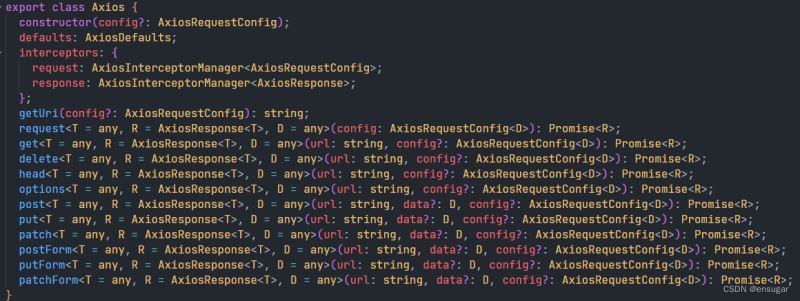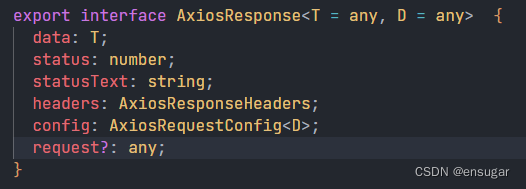如何使用TS对axios的进行简单封装
enwinter 人气:01.安装axios
npm i axios
2.在合适路径下新建request.ts(名称可随意),例如可以在项目的src下创建utils文件夹创建request.ts

3.导入axios并创建axios实例
//引入axios
import axios from 'axios'
//使用指定配置创建axios实例
const instance = axios.create({
// 基础路径
baseURL: 'http://pcapi-xiaotuxian-front-devtest.itheima.net/',
// 请求超时时间
timeout: 5000,
// ....其他配置
})
4.封装请求函数
① 查看axios的类型声明文件

② 请求配置对象的类型

从图中可知AxiosRequestConfig是axios请求配置对象的接口,例如下面的代码,axios函数的第一个参数就是AxiosRequestConfig接口的实例。而泛型D则是请求配置对象(axios函数的第一个参数)中data的类型,默认类型为any,因为AxiosRequestConfig接口内容太多就不列出来了。
axios({
url: 'http://',
method: 'post',
data: {}
// ....
})
③ 响应对象的类型

axios发送数据请求后会返回的promise实例,AxiosResponse就是这个promise实例成功后回调函数的第一个参数的类型,例如下面的代码,代码中的response的类型就是AxiosResponse。
axios({
url: 'http://',
method: 'post',
data: {}
}).then((response) => {
console.log(response.data)
})
从下图可知,AxiosResponse接口第一个泛型参数T,泛型T就是AxiosResponse接口中data的数据类型,默认类型为any,也就是上图response.data的类型。第二个泛型参数和请求配置对象一样,是AxiosRequestConfig接口中data的类型,默认类型为any。

④ axios.request函数
从axios的声明文件中可以看出直接使用axios()发送网络请求是不能指定泛型参数的,而axios.request()对泛型的支持非常友好,请看下图

request函数的第一个泛型T指定了第二个泛型AxiosResponse接口中data的类型。第二个泛型R默认为AxiosResponse,指定了request函数返回的promise实例成功的回调函数的第一个参数的类型。第三个泛型D指定了请求配置对象中data的数据类型。(看不懂的话,请再结合第②③点再看一次)
⑤ 开始封装
// 后台给我们的数据类型如下
// 泛型T指定了Response类型中result的类型,默认为any
type Response<T = any> = {
// 描述
msg: string
// 返回的数据
result: T
}
// AxiosRequestConfig从axios中导出的,将config声明为AxiosRequestConfig,这样我们调用函数时就可以获得TS带来的类型提示
// 泛型T用来指定Reponse类型中result的类型
export default <T> (config: AxiosRequestConfig) => {
// 指定promise实例成功之后的回调函数的第一个参数的类型为Response<T>
return new Promise<Response<T>>((resolve, reject) => {
// instance是我们在上面创建的axios的实例
// 我们指定instance.request函数的第一个泛型为Response,并把Response的泛型指定为函数的泛型T
// 第二个泛型AxiosResponse的data类型就被自动指定为Response<T>
// AxiosResponse从axios中导出的,也可以不指定,TS会自动类型推断
instance.request<Response<T>>(config).then((response: AxiosResponse<Response<T>>) => {
// response类型就是AxiosResponse<Response<T>>,而data类型就是我们指定的Response<T>
// 请求成功后就我们的数据从response取出并使返回的promise实例的状态变为成功的
resolve(response.data)
}).catch((error :any) => {
// 请求失败的处理
reject(error)
})
})
}
⑥ 使用
import request from "@/utils/request";
// 商品分类
export interface Category {
id: string;
name: string;
picture: string;
children: Category[];
goods: CategoryGoods[];
}
// 商品分类下的商品
export interface CategoryGoods {
id: string;
name: string;
desc: string;
price: string;
picture: string;
}
/**
* 获取首页商品分类
* @returns 首页商品分类数组
*/
export const reqGetCategory = () => {
// 指定我们封装的request函数的第一个泛型的类型为Category[],也就是指定 Response<T> 中T的类型
return request<Category[]>({
url: '/home/category/head',
method: 'get'
})
}
这样我就可以得到类型提示了
下图resonse的类型是Response

下图response.result的类型是Category[]

下图是response.result数组中元素的类型是Category

从下图我们可以看出response的类型

还可以在拦截器里添加更多功能,这里就不再赘述了。如有错误,请多包涵。
总结
加载全部内容